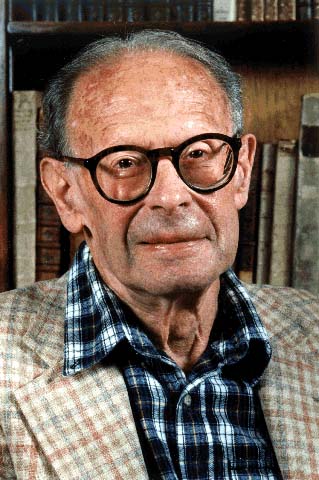
Andre
Weil
(1906 - 1998)
André Weil (May 6, 1906 - August 6, 1998) was one of the great mathematicians of the 20th century, whether measured by his research work, its influence on future work, exposition or breadth. He is known for his foundational work in number theory and algebraic geometry. He was a founding member, and de facto the early leader, of the influential Bourbaki group. The philosopher Simone Weil was his sister.
Life
Born in Paris to Alsatian parents who fled the annexation of Alsace-Lorraine to Germany, he studied in Paris, Rome and Göttingen and received his doctorate in 1928. He spent two academic years at Aligarh Muslim University from 1930. Sanskrit literature was a life-long interest of his. He had a one-year position in Marseilles, and then spent six years in Strasbourg. He married Eveline in 1937.
Weil was in Finland when World War II broke out; he had been travelling in Scandinavia since April 1939. Eveline returned to France, but he did not. A famous anecdote was confirmed in his autobiography: after having been arrested under suspicion of espionage in Finland, when the USSR attacked on 30 November 1939, he was saved from being shot only by the intervention of Rolf Nevanlinna. He returned to France via Sweden and the United Kingdom, and was detained at Le Havre in January 1940. He was charged with failure to report for duty, and was imprisoned in Le Havre and then Rouen. It was there in the military prison in Bonne-Nouvelle, a district of Rouen, from February to May, that he did the work that made his reputation. He was sent to trial on May 3, 1940. Sentenced to five years, he asked to be sent to a military unit instead, and joined a regiment in Cherbourg. After the fall of France, he met up with his family in Marseilles, where he arrived by sea. He then went to Clermont-Ferrand, where he managed to join Eveline, who had been in the German-occupied region. In January 1941 they left by sea from Marseilles, and sailed to New York.
During the war, Weil went to the United States where he was supported by the Rockefeller Foundation and Guggenheim Foundation. He was at the Universidade de São Paulo for two years from 1945, where he spent much time with Oscar Zariski. He taught at the University of Chicago from 1947 to 1958 before settling at the Institute for Advanced Study in Princeton.
Work
He made substantial contributions in many areas, the most important being profound connections between algebraic geometry and number theory. This began in his doctoral work leading to the Mordell-Weil theorem (1928, and shortly applied in Siegel's theorem on integral points). Mordell's theorem had an ad hoc proof; Weil began the separation of the infinite descent argument into two types of structural approach, by means of height functions for sizing rational points, and by means of Galois cohomology, not to be named as that for two more decades. Both aspects have steadily developed into substantial theories.
Among his major accomplishments were the 1940 proof, while in prison, of the Riemann hypothesis for local zeta-functions, and his subsequent laying of proper foundations for algebraic geometry to support that result (from 1942 to 1946, most intensively). By modern standards his claim to have a proof had a very easy ride, but wartime conditions were one factor, and the fact that the German experts made little or no comment another. The so-called Weil conjectures were hugely influential from around 1950; they were later proved by Bernard Dwork, Alexander Grothendieck, Michael Artin, and Pierre Deligne, who completed the most difficult step in 1973.
He had introduced the adele ring in the late 1930s, following Claude Chevalley's lead with the ideles, and given a proof of the Riemann-Roch theorem with them (a version appeared in his Basic Number Theory in 1967). His 'matrix divisor' (vector bundle avant le jour) Riemann-Roch theorem from 1938 was a very early anticipation of later ideas such as moduli spaces of bundles. The Weil conjecture on Tamagawa numbers proved resistant for many years. Eventually the adelic approach became basic in automorphic representation theory. He picked up another credited Weil conjecture, around 1970, which later under pressure from Serge Lang became known as the Shimura-Taniyama conjecture based on the presentation of the basic ideas at the 1955 Nikko conference. His attitude towards conjectures struck many in the field as oblique; he wrote that one should not dignify a guess as a conjecture lightly, and in the Shimura-Taniyama case the evidence was only there after extensive computational work.
Other significant results were on Pontryagin duality and differential geometry. He introduced the concept of uniform space in general topology. His work on sheaf theory hardly appears in his published papers, but correspondence with Henri Cartan in the late 1940s proved most influential.
His discovery that the so-called Weil representation, previously introduced in quantum mechanics by Irving Segal and Shale, gave a proper framework for understanding the classical theory of quadratic forms, and was also a beginning of a substantial development connecting representation theory and theta-functions.
His books, unusually for mathematics, had an important influence on research. (In one major case possibly negative: Alexander Grothendieck is supposed to have complained of the 'aridity' of Weil's Foundations of Algebraic Geometry. This is a good joke, if unintentional.) Through Bourbaki's writings and seminars, Weil's ideas can also be traced in the mainstream of post-war mathematics.
More trivially, he invented the notation "Ø" for the empty set (q.v.).
Courtesy of:
http://en.wikipedia.org/wiki/André_Weil